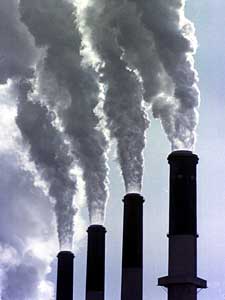- Quantitative analysis of air bubbles trapped in Antarctic ice core samples acquired and provided by the CSIRO and the Australian Antarctic Division.
- Measurement of carbon isotopes in old trees
- Acid rain
- Photochemical smog
Acid rain forms due oxides of sulphur and nitrogen reacting with the water in the atmosphere. The effects of acid rain has resulted in damage to buildings made of carbonates, such as concrete, mortar, limestone and marble, as it causes such structures to gradually dissolved away. Acid rain also damages forests and aquatic life. Therefore, an increase in the incidence of acid rain suggests oxides of sulphur and nitrogen has increased.
The CSIRO and the Australian Antarctic Division has drilled holes in the Antarctic to obtain ice core samples. By analysing the amount of oxides of sulphur and nitrogen at different levels, these ice core samples indicate that there has been an increase in the atmospheric concentration of the oxides.
Photochemical smog is a mixture of pollutants that are formed when nitrogen oxides and volatile organic compounds (VOCs) react to sunlight, creating a brown haze above cities. The worsening of such smogs shows that oxides of nitrogen and sulphur have increased.
There is difficulty in acquiring accurate evidence to show increases in the concentration of nitrogen and sulphur oxides. While atmospheric CO2 concentrations are about 360 parts per million (ppm), concentrations of SO2 and NOx are only about 0.001 ppm in populated parts of the Earth. The instruments capable of measuring very low concentrations, like those for SO2, have only been available since the 1970s. Thus long term trends have not yet been formed, and an accurate analysis can not be made.
Nitrogen dioxide form nitrogen ions, just as sulphur dioxide form sulphur ions. Both of these are soluble in water. This means that they easily travel around the biosphere and hydrosphere, making them difficult to study.
Since the Industrial Revolution in the 1800’s there has been and increase in SO2 and NOx pollution. This is due to the burning of fossil fuels, and the exponential increase in the use of automotive vehicles. Although the causes of these oxides can be measured, the oxides themselves in the atmosphere are hard to monitor.
Accurate measures of atmospheric oxides of sulphur and nitrogen currently do not exist. Even if there were accurate measures, there is no data to compare them to, as they have only been detected around the 1970s. However, there is adequate indirect evidence to show that there has been a significant increase in the atmospheric concentrations of oxides of nitrogen and sulphur.




